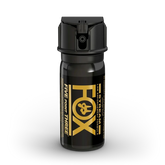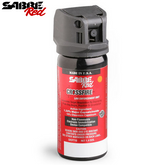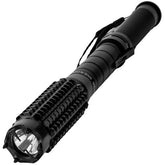Bear Spray Stops Aggressive Grizzly Attack
What a difference pepper spray can make. That’s the confirmed thinking of Dan Kotter after he recently deterred a charging grizzly bear in the Great Bear Wilderness while working on a bear population research project.
Kotter was hiking alone on the Devil Creek Trail about 5 miles in from the U.S. 2 trailhead on Oct. 8. He intended to hike in 15 miles, camp overnight and hike out the next day, but those plans were abruptly canceled.
“That morning it was fairly socked in, really foggy,” Kotter said Thursday.
He hiked up to a pass where he encountered at least two sets of bear tracks, one of which he could confirm as being left by a grizzly. So he began to proceed cautiously as he walked downhill on the other side of the pass.
“The visibility was really low. The cloud level was basically keeping me from seeing down trail, and there was a couple inches of snow,” Kotter said. “I started vocalizing a lot more, knowing there were bears in the area.”
In the middle of a “hey bear!” shout out, he heard some commotion in nearby brush.
“That’s when I thought there may have been a cub involved,” he said. “I already had my spray unvelcroed. ...
“A large bear came out of the brush, went up on its hind legs, clacked its jaws at me, came down on all fours and started a medium-paced gallop toward me.”
Kotter said he tried to remain calm and backed up slowly, but that’s when he slipped on some snowy brush and fell to the ground.
“I rolled to my left side and put my arm over my head and shot the spray toward the bear,” he recalled. “All I could do was clinch my teeth and hope I could deter the approach.”
At one point, he felt the bear’s paw step on his thigh. “And that’s what caused me to keep on spraying and spraying and waving my arm. I could hear it the whole time.”
Although Kotter was not looking directly at the bear, he is confident he hit it with the spray, because he was spraying in the direction the bear was approaching from and it quickly retreated back into the brush.
It all occurred in a blur, but it is unforgettable for Kotter.
“Whenever something that big is moving toward you, it’s really hard to think and respond. ... I was shaking really badly,” he said.
The incident put an end to the day’s hike, with Kotter quickly returning to the trailhead.
“I’m not sure how long it will take me to hike alone again,” he said. “It was a really good comfort to know that hiking with bear spray is a great deterrent. It makes me feel very safe that it did work.”
That hike, like many others Kotter has been on this year, wasn’t purely recreational. He is among about 30 people working under Kate Kendall, a U.S. Geological Survey scientist who is a leading grizzly bear population researcher.
The Devil Creek Trail is a route that Kotter has traveled before, collecting bear hair samples from rub trees that are repeatedly used by bears along the trail. Kendall is using rub tree hair samples from across the Northern Continental Divide Ecosystem to monitor grizzly bear population trends.
Last year, genetic analysis of collected hair samples led to the identification of 335 individual bears. Kendall calculates that’s about one-third of the estimated grizzly bear population in the ecosystem, which encompasses Glacier National Park, the Bob Marshall Wilderness Complex and surrounding bear habitat.
Kendall has been doing DNA-based population research for more than a decade.
“Obviously with the hundreds of people on these projects, some have had encounters with bears and some have had bluff charges,” said Kendall, who has been bluff charged by a grizzly herself. “But we haven’t had any injuries. This is definitely the closest call.”
Kendall said Kotter’s story is important because it demonstrates that even when a person is careful, a surprise encounter is still possible, and it is another example of pepper spray being an effective bear deterrent.
“I think it is really good to get this story out there so people can see the value of not only carrying bear spray with you, but carrying it on your hip where it’s accessible and can be used at a moment’s notice,” she said. “He didn’t have a lot of time.”
 By DailyInterLake
By DailyInterLake
 By DailyInterLake
By DailyInterLake
Shop Stun Batons
Stun Master 110,000,000 Volt Bad Ass Metal Stun Baton And Flashlight
18 reviews
Looks like a police "billy club" and delivers an amazing 110 million volts of electricity 4.9 milliamps depending on the charge of the batteries Made from some of the strongest material on the planet - high-quality aircraft aluminum High-end tactical 120 Lumen LED flashlight Firm rubberized contoured grip...
- $49.95
$59.95- $49.95
- Unit price
- / per
Streetwise Mini Barbarian Stun Baton Flashlight 9,000,000
2 reviews
The MINI Barbarian is the perfect name for our newest stun baton. If Conan the Barbarian lived in modern times, we are sure this would be his weapon of choice. Even in our more refined culture, there are still “barbarians” who roam the streets....
- $49.95
$54.95- $49.95
- Unit price
- / per
Streetwise Barbarian 9,000,000* Stun Baton Flashlight
5 reviews
Protecting yourself with the Barbarian is as easy as 1,2,3: Identify Threat: An attacker will use the cover of darkness to sneak up on their victims and to hide their identity. He'll also look for the most vulnerable victim. This powerful light beam shined...
- $55.95
- $55.95
- Unit price
- / per
Streetwise Attitude Adjuster Stun Baton Flashlight
3 reviews
Adjusts from 16.5" to 19": With a quick twist of the handle, you can adjust this unit to any desired length between 16.5" and 19". Triple Stun Technology: Most stun guns on the market today have only one or two points of contact. When...
- $59.95
- $59.95
- Unit price
- / per














